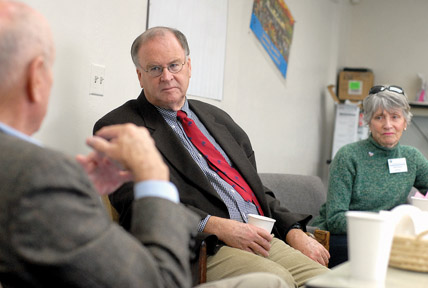
Nonprofit members discuss needs with congressman at local Food
Bank
Board members from the Community Food Bank of San Benito County
and Mary Anne Hughes, the executive director, sat down with
Congressman Sam Farr for a candid talk about the needs of the
nonprofit as well as the community in general.
The stop was one of three that the Carmel Democrat made in San
Benito County on Monday, including a trip to San Benito High School
and Pacific Scientific. In December, Pacific Scientific was awarded
a $1.5 million federal contract to make Tactical RPG Airbag
Systems. Community Food Bank recevied $150,00 in stimulus funding
in December, and an additional allocation of $52,130 in
January.
Nonprofit members discuss needs with congressman at local Food Bank
Board members from the Community Food Bank of San Benito County and Mary Anne Hughes, the executive director, sat down with Congressman Sam Farr for a candid talk about the needs of the nonprofit as well as the community in general.
The stop was one of three that the Carmel Democrat made in San Benito County on Monday, including a trip to San Benito High School and Pacific Scientific. In December, Pacific Scientific was awarded a $1.5 million federal contract to make Tactical RPG Airbag Systems. Community Food Bank recevied $150,00 in stimulus funding in December, and an additional allocation of $52,130 in January.
The underlying theme of the meeting seemed to be finding ways to connect efforts, regionally, and in the community between nonprofits and government agencies.
“What is broken that needs fixing?” Farr asked, at the beginning of the meeting.
Hughes was quick with an answer.
“My frustration is that we’ve been doing this here for a little while and we are getting to the point where we are pretty good at feeding people,” Hughes said. “But no matter how good or well we are doing, we never make any progress because we don’t have jobs.”
She said most of the clients with whom she works would prefer to have a job earning enough to provide food for their families. She added that though some training programs are available, they have not been successful at transitioning people into full-time employment.
Farr said that some of the training programs require a business owner to agree to hire the person on after the training is complete, but Hughes argued that “a lot of employers don’t want to sign that because they can’t guarantee they will have a job.”
The unemployment rate in San Benito County as last reported for December 2009 was 18.7 percent, according to the State of California Employment Development Department.
Other board members and volunteers mentioned the impact of two-thirds of the population traveling out of the county for work. Others mentioned the closing of manufacturing businesses in the last few decades, as well as the sewer moratorium, which brought development in Hollister to a halt.
“We thought as soon as the sewers started working, we’d be up but then the economy was not,” Hughes said.
Farr mentioned some areas for growth in San Benito County, such as green industry, agriculture, tourism and expansion at the Hollister Municipal Airport.
“We need to look at what we have here that can be value added,” he said.
Farr also mentioned his work to turn Pinnacles National Monument into a national park.
“Most people think a monument is just a statue,” he said. “We need to save the character of the town and make it economically viable.”
Some of the talk revolved around making San Benito into a tourist destination, since it is so often overlooked by visitors to the region even though it has award-winning wineries, Pinnacles, the San Juan Mission and other stops of interest.
Farr also mentioned the importance of the upcoming census count in March.
“Of the 58 counties in California, San Benito gets the least amount of federal money,” he said.
He explained that federal money comes back to the community in three ways. The first is through formulas that are based on the census numbers, for things such as education, public safety and others. The second way is through grants, which are competitive and for which individual communities have to apply. The third is through earmarks, which congressmembers allocate for specific projects.
“The census will increase the revenue,” he said.
At the end of the discussion, Farr toured the Community Food Bank distribution center, where volunteers worked quickly to fill paper bags with food staples such as canned goods, rice and beans. The clients stood in a line 30 people deep that curved into the parking lot. The bags also included a bag of lettuce and some produce.
“We need to work on getting the right kind of food,” Farr said. “The [United States Department of Agriculture] hasn’t bought lettuce. It’s always been canned goods, beans, things that are easy to store. It hasn’t changed even though you can get produce anywhere overnight.”









